Emboss Swept Example 1
Introduction
This help topic provides a basic example to help you get started creating Emboss Swept features. By providing the fundamental information about this feature type, this topic can be useful for beginners or advanced users alike.
For this example, you start from a new BobCAD file. The entire process of creating an Emboss feature is explained.
Important Notes
- There are two geometry items used: the feature geometry and the cross section.
- The feature geometry defines the path of the sweep (in X and Y).
- The cross section defines the shape of the emboss (in Z) that is swept along the feature geometry.
- The feature geometry can be either open or closed geometry chains.
- One or more chains can be selected for a single feature.
Example
Part 1) Create Geometry
The Emboss Swept feature geometry can be any combination of open or closed chains. The entities used for the chains can be any combination of lines, arcs, and splines.
-
In the Quick Access Toolbar, click
 New.
New. -
In the Entity group, of the Create 2D ribbon, click the down arrow under
 Arc, and select
Arc, and select  Arc Center.
Arc Center. -
In the Data Entry Manager, type the following values.
Arc Coordinate
|
Center X |
3.50 |
|
Center Y |
3.50 |
|
Center Z |
0.00 |
|
Radius |
2.00 |
|
Start Angle |
0.00 |
|
End Angle |
360.00 |
-
After typing the values, the CAD preview is updated in the graphics area.
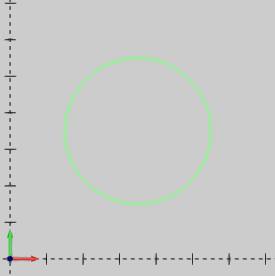
-
To create the arc, as shown in the preview, click OK.
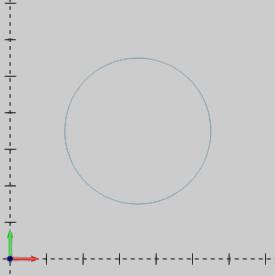
-
The geometry creation for the feature is complete. To close the Arc function, click Cancel.
Part 2) Create Stock
-
In the
 BobART Manager, right-click
BobART Manager, right-click
 Emboss Model,
and click Create/Modify Stock.
Emboss Model,
and click Create/Modify Stock. -
In the Stock Parameters dialog box, in the Origin group, double-click (click twice quickly) in the X box so that the entire value is selected. Type 1.000 and press Tab.
-
In the Y box, type 1.000.
The Origin settings define the lower-left corner (origin) of the stock in the graphics area. The Origin values set the distance from the WCS or world coordinate system. This is also known as
the CAD coordinate system.
WCS or world coordinate system. This is also known as
the CAD coordinate system. -
In the Model Size group, set the X value to 5.00, and set the Y value to 5.00.
These values represent the length of the stock along each of the X- and Y-axes. -
To set the color of the stock, click Color. In the Color dialog box, click a color and then click OK. For this example, click the fifth color in the first row (Row 1, Column 5).
-
The stock parameters are now defined. To close the dialog box and create the stock, click OK.
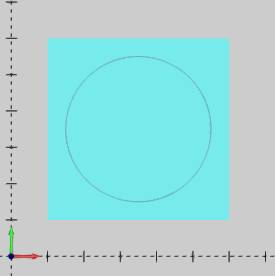
Notice the location of the stock origin (lower-left corner). Also note that the geometry created earlier is contained within the bounds of the stock.
The stock for embossed models is created with zero thickness.
Part 3) Add the Feature
-
In the
 BobART
Manager, right-click
BobART
Manager, right-click  Emboss
Model, and click Emboss Swept.
Emboss
Model, and click Emboss Swept. -
In the Emboss dialog box, in the Emboss Attributes group, click in the Name box.
-
At the beginning of the description, type My so that the description displays My Emboss Swept 1.
-
To define the color of the feature, click Color. In the Color dialog box, click a color and click OK.
-
In the Emboss group, confirm that Convex Arc is selected. Also confirm that the Application Type is set to Add.
-
In the Radius box, type 0.500. Notice that the cross section preview is updated in the dialog box.
All of the other settings remain at the default values.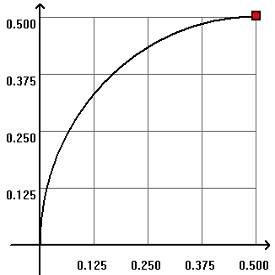
-
To close the dialog box and add the feature to the BobART tree, click OK.
In the BobART tree, notice that the feature, ![]() My Emboss Swept 1 - Add, is added under
My Emboss Swept 1 - Add, is added under ![]() Emboss Model. The red x
through the Emboss icon lets you know that the model needs to be Regenerated
to update the current settings. The model is Regenerated after selecting
geometry in the next part.
Emboss Model. The red x
through the Emboss icon lets you know that the model needs to be Regenerated
to update the current settings. The model is Regenerated after selecting
geometry in the next part.
Part 4) Select Geometry
-
In the BobART tree, under
 My Emboss Swept 1 - Add, right-click
My Emboss Swept 1 - Add, right-click

 Geometry,
and click Re/Select.
Geometry,
and click Re/Select. -
In the graphics area, point to the arc that you created earlier. When the arc changes to the highlight color, click the arc. (Because it is a single entity, the entire arc is selected.)
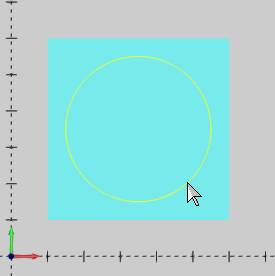
The arc then changes to the selection color to show that it is selected.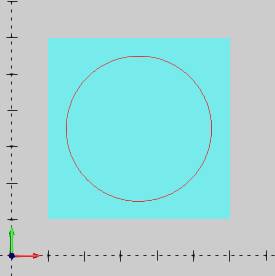
-
To confirm the selection, right-click anywhere in the graphics area, and click
 OK.
OK.
The geometry selection for the feature is complete.
Tip: When selecting
geometry for Emboss features, you often need to hide the embossed model.
To hide the Embossed model/stock, do one of the
following:
• Right-click
![]() Emboss Model, and
click Blank/Unblank.
Emboss Model, and
click Blank/Unblank.
• You can
also use the keyboard shortcut E.
To use this method, click anywhere in the graphics area (so that
it has key focus), and press E
on the keyboard.
Part 5) Regenerate
When working with Emboss features, every time that you add a new feature or modify an existing feature, the model must be regenerated.
- To add the Emboss feature to the model, right-click
 Emboss
Model, and click Regenerate.
Emboss
Model, and click Regenerate.
Notice the red x through the icon. This symbol
means that changes have been made that are not yet included in the model.
After regenerating, the symbol changes to ![]() Emboss Model.
Emboss Model.
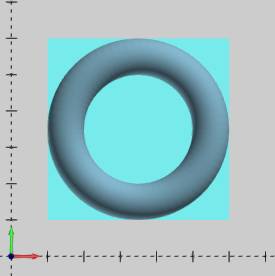
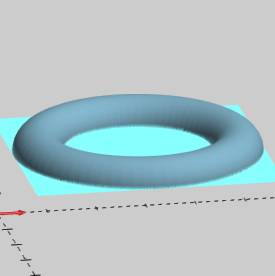
Notice that the cross section, defined in the Emboss dialog box, is swept along the entire length of the feature geometry. The cross section defines the shape of the emboss vertically in Z. The Application Type, Add, means that the feature is added (or raised) in the positive Z-axis. The Z-height of the feature is 0.500 inches because of the 0.500 radius (Convex Arc) cross section used.
Part 6) Edit the Feature
After creating an Emboss Swept feature, you can edit the feature to make changes to the model. To edit the feature, you use the Emboss Feature in the BobART Tree.
-
In the BobART tree, right-click
 My
Emboss Swept 1 - Add, and click
Edit.
My
Emboss Swept 1 - Add, and click
Edit. -
In the Emboss dialog box, click the Cross Section arrow and click Concave Arc.
-
To close the dialog box, click OK.
-
To update the model and show the result of the new setting, right-click
 EmbossModel, and click Regenerate.
EmbossModel, and click Regenerate.
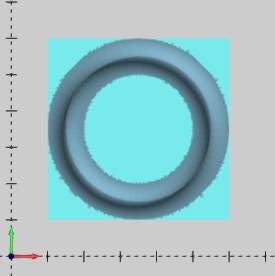
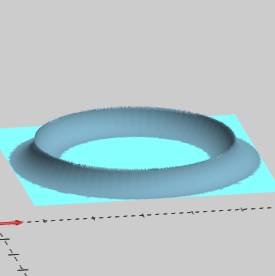
Again, the defined cross section is swept along both sides of the selected feature geometry. -
Edit the feature (as in step 1).
-
In the Emboss group, click the Application Type arrow and click Subtract. This means that the feature is lowered in the negative Z-axis direction.
-
Click OK to close the dialog box, and Regenerate the model (as in step 4).
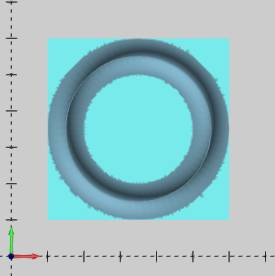
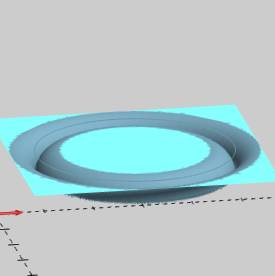
Part 7) Create a Line
-
In the Entity group, of the Create 2D ribbon, and click
 Line.
Line.
-
In the Data Entry Manager, double-click in the Start X box and type 1.50.
-
Press Tab, and type 1.500 in the Start Y box.
-
Press Tab twice. In the End X box type 5.50, and in the End Y box, type 5.50.
-
After typing the values, the CAD preview (displayed in green) is updated in the graphics area.
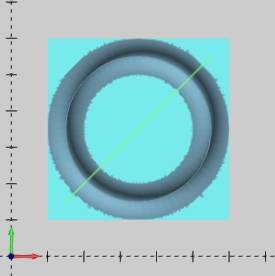
-
To create the line, as shown in the preview, click OK.
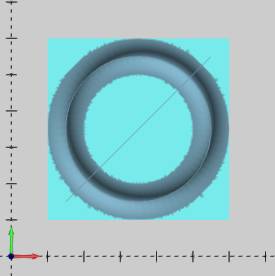
-
The geometry creation is complete. To close the Rectangle function, click Cancel.
Part 8) Select Multiple Chains for a Single Feature
You can select multiple chains for a single Emboss Swept feature. The process of sweeping the cross section along the chain to create the emboss is applied to each chain regardless of how many chains are selected.
Tip: In
the BobART tree, click ![]() My
Emboss Swept 1 - Subtract. Notice that the feature geometry is
highlighted in the graphics area. You can use this preview to locate each
feature when the BobART tree contains multiple features.
My
Emboss Swept 1 - Subtract. Notice that the feature geometry is
highlighted in the graphics area. You can use this preview to locate each
feature when the BobART tree contains multiple features.
-
To hide the model, click anywhere in the graphics area, and press E.
-
In the
 BobART Manager, right-click
BobART Manager, right-click  Geometry, and click Re/Select.
Geometry, and click Re/Select.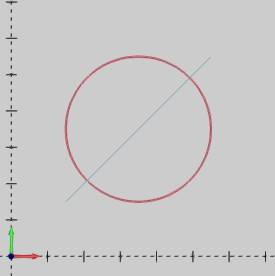
Notice that the previous feature geometry is still highlighted. This shows that it is still selected. -
In the graphics area, click the line to select it.
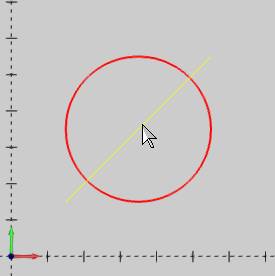
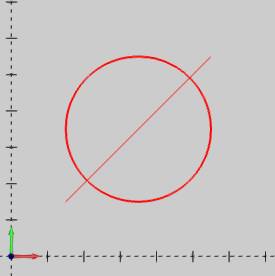
-
To confirm the selection, press the Spacebar. (This is the same as clicking
 OK in the graphics area shortcut menu.)
OK in the graphics area shortcut menu.)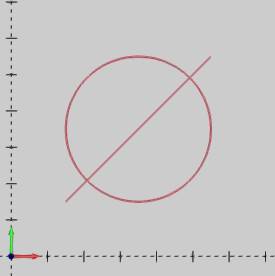
Notice that the feature preview is shown after confirming the geometry selection. This is because the Geometry item in the
Geometry item in the  BobART tree is currently selected. Click
BobART tree is currently selected. Click  Emboss
Model and the preview is no longer shown.
Emboss
Model and the preview is no longer shown. -
Right-click
 My
Emboss Swept 1 - Subtract, and click Edit.
My
Emboss Swept 1 - Subtract, and click Edit. -
Set the Cross Section to Convex Arc, and set the Application Type to Add. Click OK.
-
To update the model, right-click
 Emboss
Model, and click Regenerate.
Emboss
Model, and click Regenerate.
To show the model, click anywhere in the graphics area, and press E.
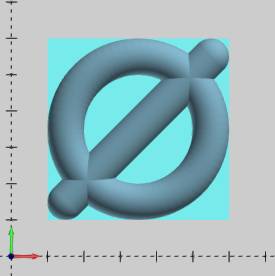
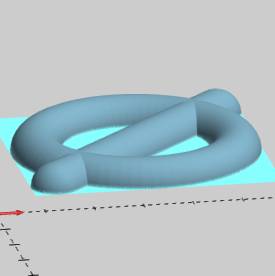
Note: When
combining multiple emboss features, the Add application type adds the
results of each feature together. In the previous images, because the
two separate chains were selected for a single Emboss Swept feature, they
are created at the same height (0.50). The following images show the result
of creating two Emboss Swept features and assigning the arc to one feature
and assigning the line to the other feature.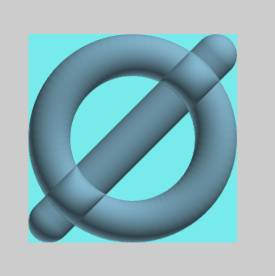
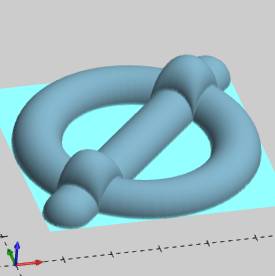
The result is that the intersecting areas
of the two features are added together. The 0.50 arc used for each feature
results in the total Z-height of the model of 1.00.
Part 9) Modifying the Cross Section
When using the cross-section types, Convex Arc or Concave Arc, you can modify the cross section using the Start Angle and End Angle parameters.
-
Right-click My Emboss Swept 1 - Add, and click Edit.
-
In the Emboss dialog box, in the Start Angle box, type 45.00.
This causes the cross section to start at the midpoint of the arc (45 is half of 90). The range of possible values for the Start Angle and End Angle are from 0.00 to 90.00 degrees. -
To close the dialog box, click OK.
-
To view the change in the model, Regenerate.
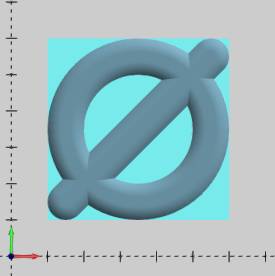
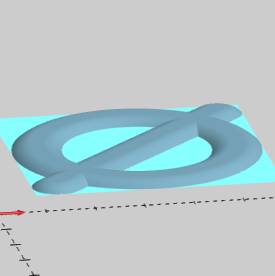
The Z-height of the model is now much lower than the previous result. To find the height of the model, right-click anywhere in the graphics area, and click Entity Summary. In the Bounds group, notice the Z Total box displays 0.1464. This is exactly the height of an arc with a 0.500 inch radius drawn from 45 degrees to 90 degrees.
Part 10) Modify the Cross Section in the Emboss Dialog Box
When using any of the standard cross-section types in the Emboss dialog box, you can manually edit the cross section using the cross section preview that is displayed in the dialog box.
-
Edit the feature. In the Emboss group, click the Cross Section arrow and click Line
-
In the preview, click the red point on the right side. Drag (click and hold the mouse button) the point left to the vertical 0.125 grid line as shown next.
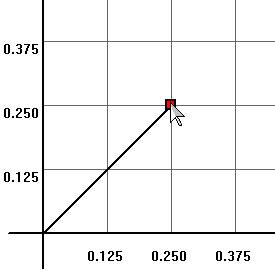
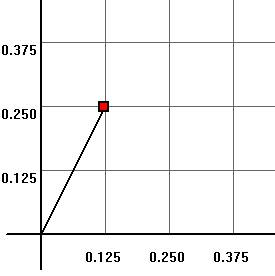
-
Notice that the parameters of the line are updated in the Cross Section group.
-
Click OK.
-
Regenerate the model to view the changes.
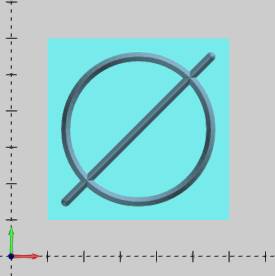
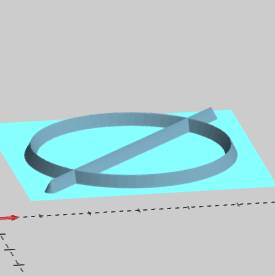
Part 11) Using Fast Edit
The Fast Edit section of the Emboss dialog box is used to scale the cross section or to add a base height which creates a wall at the bottom of the feature.
-
To better show the results of using the Fast Edit parameters, edit the feature.
Set the Cross Section to Convex Arc, and set the Radius to 0.50. Set the Start Angle to 0.00.
Regenerate the feature. The model should appear as it did earlier in this example.
-
Edit the feature. In the Fast Edit group, set the Base Height to 1.00.
-
Click OK, and Regenerate the model.
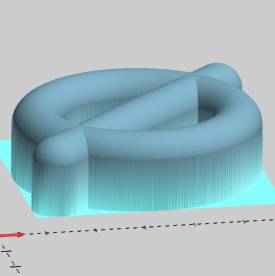
-
Edit the feature. In the Fast Edit group, set the X-Y Scale to 0.500, and set the Z Scale to 1.500.
These settings cause the defined cross section to be 50 percent of the size in the X- and Y-axes and 150 percent of the size in the Z-axis. -
Regenerate the feature to show the results.
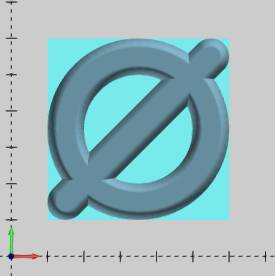
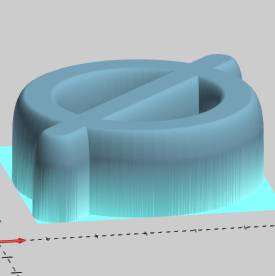
Note: When using the X-Y Scale and Z Scale parameters, only the Cross Section is scaled. The scaling does not affect the Base Height or the feature geometry.
Part 12) Define a Custom Cross Section
In addition to using the standard cross-section types that are available in the Emboss dialog box, you can also define a custom cross section using geometry that you create in the graphics area.
To learn more, view How to Use a Custom Cross Section.
This concludes the example.
